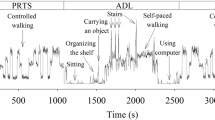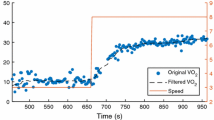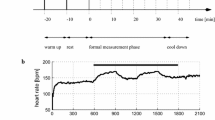Abstract
This paper aims to establish a block-structured model to predict oxygen uptake in humans during moderate treadmill exercises. To model the steady state relationship between oxygen uptake (oxygen consumption) and walking speed, six healthy male subjects walked on a motor driven treadmill with constant speed from 2 to 7 km/h. The averaged oxygen uptake at steady state (VO 2) was measured by a mixing chamber based gas analysis and ventilation measurement system (AEI Moxus Metabolic Cart). Based on these reliable date, a nonlinear steady state relationship was successfully established using Support Vector Regression methods. In order to capture the dynamics of oxygen uptake, the treadmill velocity was modulated using a Pseudo Random Binary Signal (PRBS) input. Breath by breath analysis of all subjects was performed. An ARX model was developed to accurately reproduce the measured oxygen uptake dynamics within the aerobic range. Finally, a Hammerstein model was developed, which may be useful for implementing a control system for the regulation of oxygen uptake during treadmill exercises.








Similar content being viewed by others
References
Allin J., Inbar G. (1986) FNS parameter selection and upper limb characterization. IEEE Trans. Biomed. Eng. 33:809–817
Bai E. W. (1998) An optimal two-stage identification algorithm for Hammerstein–Wiener nonlinear systems. Automatica 34(3):333–338
Bai E. W. (2002) A blind approach to the Hammerstein model identification. IEEE Trans. Signal Proce. 50(7):1610–1619
Bai E. W. (2002) Identification of linear systems with hard input nonlinearities of known structure. Automatica 38:853–860
Bai E. W. (2004) Decoupling the linear and nonlinear parts in Hammerstein model identification. Automatica 40:671–676
Bernotas L., Crago P., Chizeck H. (1986) A discrete-time model of electrically stimulated muscle. IEEE Trans. Biomed. Eng. 33:829–838
Bilings S. A., Fakhouri S. Y. (1978) Identification of a class of nonlinear systems using correlation analysis. Proc. Inst. Elect. Eng. 125(7):691–697
Bussgang, J. J. Crosscorrelation functions of amplitude distorted Gaussian signals. Tech. Rept. 216, MIT Res. Lab. of Electronics, 1952.
Chang F., Luus R. (1971) A noniterative method for identification using Hammerstein model. IEEE Trans. Automat. Contr. 16:464–468
Cristianini N., Shawe-Taylor J. (2000) An Introduction to Support Vector Machines and other Kernel-based Learning Methods. Cambridge University Press, UK
Dempsey E. J., Westwick D. T. (2004) Identification of Hammerstein models with cubic spline nonlinearities. IEEE Trans. Biomed. Eng. 51:237–245
Dill D. B. (1965) Oxygen used in horizontal and grade walking and running on the treadmill. J. Appl. Physiol. 20:19–22
Drucker, H., C. Burges, L. Kaufman, A. Smola, and V. Vapnik. Support vector regression machines. In: Advances in Neural Information Procession Systems, edited by M. Mozer, M. Jordan, and T. Petsche. Cambridge MA, 1997, pp. 155–161.
Efeld D., Hoffmann U., Stegemann J. (1987) VO 2 kinetics in subjects differing in aerobic capacity: investigation by spectral analysis. Eur. J. Appl. Physiol. 56(5):508–515
Eskinat E., Johnson S. H., Luyben W. L. (1991) Use of Hammerstein models in identification of nonlinear systems. AIChE J. 37:255–268
Espinoza, M., K. Pelckmans, L. Hoegaerts, J. Suykens, J. De Brabanter, B. De Moor. A comparative study of LS-SVMs applied to the silver box identification problem. Symposium on nonlinear control systems NOLCOS, 2004, pp. 513–518.
Falugi P., Giarre L., Zappa G. (2005) Approximation of the feasible parameter set in worst-case identification of Hammerstein models. Automatica 41:1017–1024
Franklin B. A. (2000) ACSM’s Guidelines for Exercise Testing and Prescription. Lippincott Williams & Wilkins, New York
Goethals I., Pelckmans K., Suykens J. A. K., De Moor B. (2005) Identification of MIMO Hammerstein models using least squares support vector machines. Automatica 41:1263–1272
Guo Y., Bartlett P. L., Shawe-Taylor J., Williamson R. C. (2002) Covering numbers for support vector machines. IEEE Trans. Inform. Theory 48(1):239–250
Hagberg J. M., Hickson R. C., Ehsani A. A., Holloszy J. O. (1980) Faster adjustment to and recovery from submaximal exercise in the trained state. J. Appl. Physiol. 48:218–224
Hill A. V., Lupton H. (1923) Muscular exercise, lactic acid and the supply and utilization of oxygen. Q. J. Med. 16:l35–171
Hoffmann U., Efeld D., Wunderlich H.-G., Stegemann J. (1992) Dynamic linearity of VO 2 responses during aerobic exercise. Eur. J. Appl. Physiol. 64(2):l39–144
Hunt K. J., Munih M., Donaldson N. de. N., Barr F. M. D. (1998) Investigation of the Hammerstein hypothesis in the modeling of electrically stimulated muscle. IEEE Trans. Biomed. Eng. 45(8):998–1009
Hunter I. W., Korenberg M. J. (1986) The identification of nonlinear biological systems: Wiener and Hammerstein cascade models. Biol. Cybern. 55:135–144
Korenberg M. J. (1973) Identification of biological cascades of linear and nonlinear systems. Proc. Midwest Symp. Circuit Theory 18(2):1–9
Korenberg M. J. (1991) Recent advances in the identification of nonlinear systems: minimumvariance approximation by Hammerstein models. Proc. IEEE EMBS 13:2258–2259
Maksym G. N., Kearney R. E., Bates J. H. (1998) Nonparametric block-structured modeling of lung tissue strip mechanics. Ann. Biomed. Eng. 26(2):242–252
Narendra K. S., Gallman P. G. (1966) An iterative method for the identification of nonlinear systems using Hammerstein model. IEEE Trans. Automat. Contr. 11:546–550
Ninness B., Gibson S. (2002) Quantifying the accuracy of Hammerstein model estimation. Automatica 38:2037–2051
Pawlak M. (1991) On the series expansion approach to the identification of Hammerstein systems. IEEE Trans. Automat. Contr. 36:763–767
Pearce D. H., Milhorn H. T. Jr (1977) Dynamic and steady-state respiratory responses to bicycle exercise. J. Appl. Physiol. 42(6):959–967
Prampero D. I., Davies P., Cerretelli P., Margria R. (1970) An analysis of O 2 debt contracted in submaximal exercise. J. Appl. Physiol. 29:547–551
Schlkopf B., Smola A. (2002) Learning with Kernels. MIT Press, Cambridge, MA
Smola A., Schlkopf B. (2004) A tutorial on support vector regression. Stat. Comput. 14:199–222
Su S. W., Bao J., Lee P. L. (2005) Control of multivariable Hammerstein systems by using feedforward passivation. Ind. Eng. Chem. Res. 44(4):891–899
Su, S. W., L. Wang, B. Celler, A. Savkin, and Y. Guo. Identification and control for heart rate regulation during treadmill exercise. IEEE Trans. Biomed. Eng. 54(7):1238–1246, 2007.
Suykens J. A. K., Van Gestel T., de Brabanter J., de Moor B., Vandewalle J. (2002) Least Squares Support Vector Machines. WorldScientific, Singapore
Suykens J. A. K., Van Gestel, de Brabanter J., de Moor B., Vandewalle J. (2002) Least Squares Support Vector Machines. Neurocomputing 48:85–105
Vapnik V. (1995) The Nature of Statistical Learning Theory. Springer, New York
Vapnik V. (1998) Statistical Learning Theory. John Wiley, New York
Vapnik, V., and A. Lerner. Pattern recognition using generalized portrait method. Automat. Rem. Contr. 14:774–780, 1963.
Voros J. (1999) Iterative algorithm for parameter identification of Hammerstein systems with two-segment nonlinearities. IEEE Trans. Automat. Contr. 44:2145–2149
van der Walt W. H., Wyndham C. H. (1973) An equation for prediction of energy expenditure of walking and running. J. Appl. Physiol. 34:559–563
Wang, L., S. W. Su, B. Celler, and A. Savkin. Modeling of a gas concentration measurement system. Proc. IEEE EMBS. Shanghai, China, September, 2005, pp. 6695–6698.
Whipp B. J., Ward S. A., Lamarra N., Davis J. A., Wasserman K. (1982) Parameters of ventilatory and gas exchange dynamics during exercise. J. Appl. Physiol. 52(6):1506–1513
Yanagawa K., Abe D., Niihata S. (2004) Effects of load carriage, load position, and walking speed on energy cost of walking. Appl. Ergon. 35:329–335
Acknowledgment
The authors gratefully acknowledge the financial support of the Australian Research Council (Grant DP0452186).
Author information
Authors and Affiliations
Corresponding author
Rights and permissions
About this article
Cite this article
Su, S.W., Wang, L., Celler, B.G. et al. Oxygen Uptake Estimation in Humans During Exercise Using a Hammerstein Model. Ann Biomed Eng 35, 1898–1906 (2007). https://doi.org/10.1007/s10439-007-9362-2
Received:
Accepted:
Published:
Issue Date:
DOI: https://doi.org/10.1007/s10439-007-9362-2




